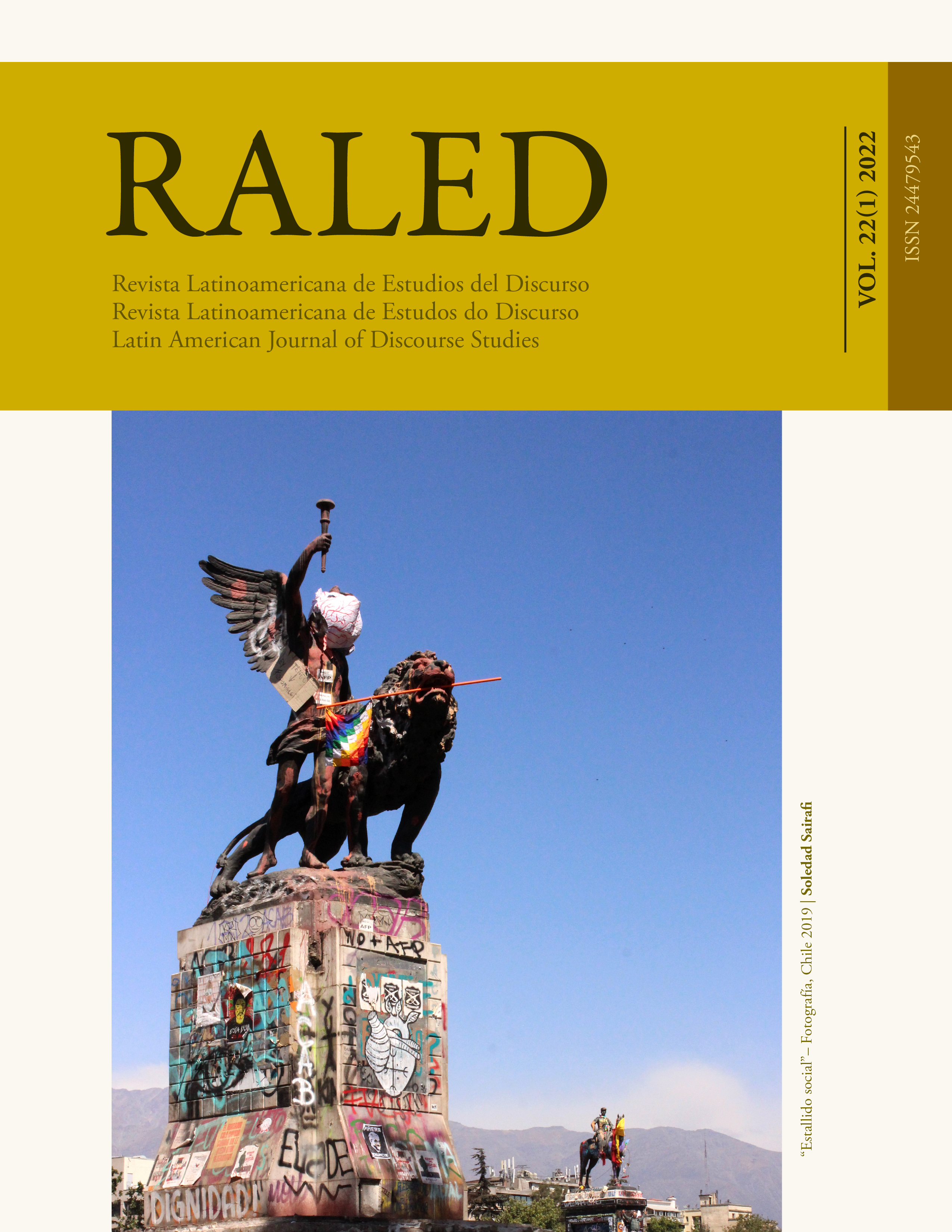Anonymity, pseudonymy and crimes in social networks: a multidimensional proposal of forensic linguistics for the identification of authorship
DOI:
https://doi.org/10.35956/v.22.n1.2022.p.122-142Keywords:
Forensic linguistic, social networks, anonymity, authorshipAbstract
Una de las primeras apreciaciones del impacto de Internet sobre el mundo social fue la creación de comunidades virtuales, que permitieron congregar personas dispersas, distantes en el espacio, pero unidas por propósitos comunes (Noblia 2000 a y b). Esta potencialidad de vincular y fomentar grupos de distinta índole, también habilitó la agrupación de individuos aunados por la “cultura del odio” (Zickmund 1997; Dery 1994). Bajo el amparo de la libertad de expresión, del anonimato/pseudonimia, grupos e individuos hacen uso de las redes sociales con el fin de difundir sus discursos radicalizados y sus programas violentos. Las dinámicas de las redes, pautada por “haters”, los ayuda a circular y convocar a nuevos adherentes. El accionar de estos grupos es un foco de preocupación para los organismos gubernamentales a cargo de fiscalizar delitos de esta índole y prevenirlos, porque, dadas las características y ámbitos de circulación, su detección temprana y su desarticulación es una tarea compleja. En esta labor, la actuación de los lingüistas forenses resulta central, ya que el análisis de los discursos es uno de los recursos clave para la identificación de sus autores. En el marco de este artículo, y en el marco de la Lingüística Forense (Coulthard 1998; Turrell 2010; Grant y Macleod 2018) nos proponemos presentar una propuesta metodológica multidimensional de análisis de autoría, que resulta productiva para los casos de pseudonimia/anonimato en redes sociales.
Downloads
References
Burrows. J. 2002. ‘Delta’: A measure of stylistic difference and a guide to likely authorship. Literary and Linguistic Computing 17, 3: 267–287.
Burrows, J. 2007. All the way through: testing for authorship in different frequency strata. Literary and Linguistic Computing 22, 1: 27–48.
Coulthard, M. 1998. Making text speak: the work of a forensic linguist. Studia Anglica Posnaniensia: International Review of English Studies 33: 117-130.
Coulthard, M. 2004. Author identification, idiolect and linguistic uniqueness. Applied Linguistics 25, 4: 431–47.
Coulthard, M. 2005. Some forensic applications of descriptive linguistics. Veredas: Revista de estudos linguisticos 9, 1.
Coulthard, M. y Johnson, A. 2007. An Introduction to Forensic Linguistics. Language in Evidence. New York: Routledge.
Dery, M. 1994. Flame wars. The discourse of Cyberculture. Durham/London: Duke University Press.
Eder M., Rybicki J. & Kestemon, M. 2016. Stylometry with R: a package for computational text analysis. R Journal, 8, 1: 107–121. En: https://journal.r-project.org/archive/2016/RJ-2016-007/index.html.
Grant, T. & Macleod, N. 2018. Resources and constraints in linguistic identity performance – a theory of authorship. Language and Law = Linguagem e Direito 5, 1: 80-96.
Halliday, M. & C. Mathiessen. 2004. An Introduction to Functional Grammar. London: Routledge.
Hawley, G. 2017. Making sense of the Alt-Right. New York: Columbia University Press.
Kress, G. 2010. Multimodality: A Social Semiotic Approach to Contemporary Communication. London & New York: Routledge.
Martin, J. & White, P. 2005. The Language of Evaluation: Appraisal in English. London: Palgrave/ Macmillan.
Mccauley, C. y Moskalenko, S. 2017. Understanding Political Radicalization: The Two-Pyramids Model. American Psychologist 72, 3: 205–216.
Nagle, A. 2017. Kill All Normies: Online Culture Wars From 4Chan and Tumblr to Trump and the Alt-Right. Washington, DC: Zero Books.
Noblia, M. V. 2000a. Internet, Comunidad virtual y control. En M. V. Noblía y M. L. Pardo (Eds.). Globalización y nuevas tecnologías, pp. 55-58. Buenos Aires: Biblos.
Noblia, M. V. 2000b. Conversación y Comunidad: los chats y la comunidad virtual. Discurso y Sociedad 2, 5.
R Core Team. 2020. R: A language and environment for statistical computing. R Foundation for Statistical Computing, Vienna, Austria. URL: https://www.R-project.org/.
Noblia, M. V. 2009. Modalidad, evaluación e identidad en el chat. Discurso y Sociedad 3, 4.
Noblia, M. V. 2012. La relación interpersonal en el chat. Procesos de construcción y negociación de la identidad. Tesis doctoral. Buenos Aires: Editorial de la Facultad de Filosofía y Letras. (UBA). E-Book.
Scollon, R. 2003. Acción y texto: para una comprensión conjunta del lugar del texto en la (inter)acción social, el análisis mediato del discurso y el problema de la acción social. En R. Wodak y M. Meyer (Eds.). Métodos de análisis crítico del discurso, pp. 220-221. Barcelona: Gedisa.
Stefanoni, P. 2021. ¿La rebeldía se volvió de derecha? Buenos Aires: Siglo XXI.
Traverso, E. 2021. Las nuevas caras de la Derecha. Buenos Aires: Siglo XXI.
Turrell, M. T. 2010. The use of textual, grammatical and sociolinguistic evidence in forensic text comparison. Speech, language and the law 17, 2: 211–250.
Van Dijk, T. 1984. Prejudice in Discourse. New York/Amsterdam: John Benjamins Publishing.
Woolls, D. 2003. Better tools for the trade and how to use them. Forensic Linguistics 10, 1: 102-112.
Zickmund, S. 1997. Approaching the radical other: the discursive culture of cyberhate. En S. Jones. Virtual Culture. Identity & Communication in Cibersociety, pp. 185-186. London: Sage.
Downloads
Published
How to Cite
Issue
Section
License
Copyright (c) 2022 Valentina Noblia, Alejandro Carlos Renato, Tomás Gershanik

This work is licensed under a Creative Commons Attribution-NonCommercial-NoDerivatives 4.0 International License.
The authors retain the copyright and guarantee RALED the right to be the first publication of the work as well as a Creative Commons Attribution License that allows others to share the work with recognition of authorship and the initial publication in this journal.




